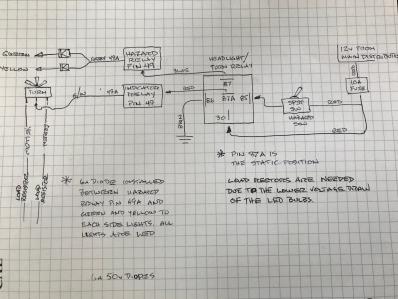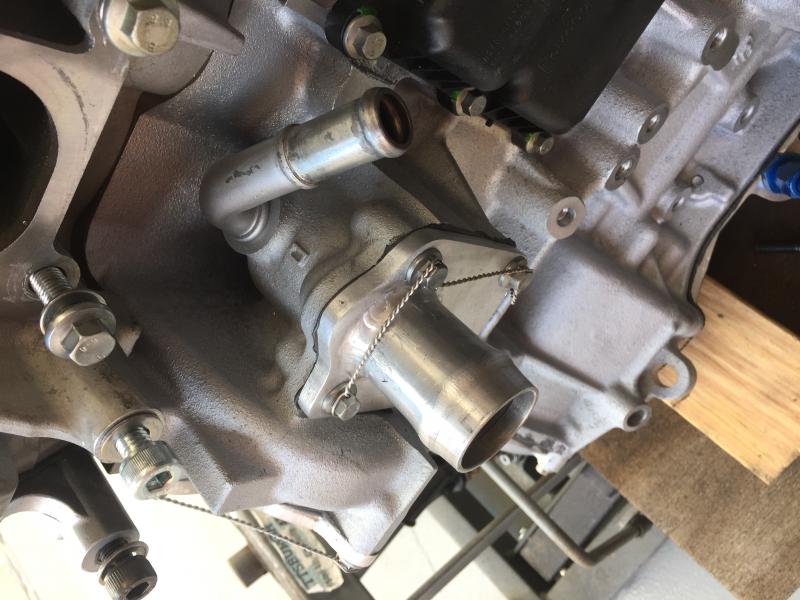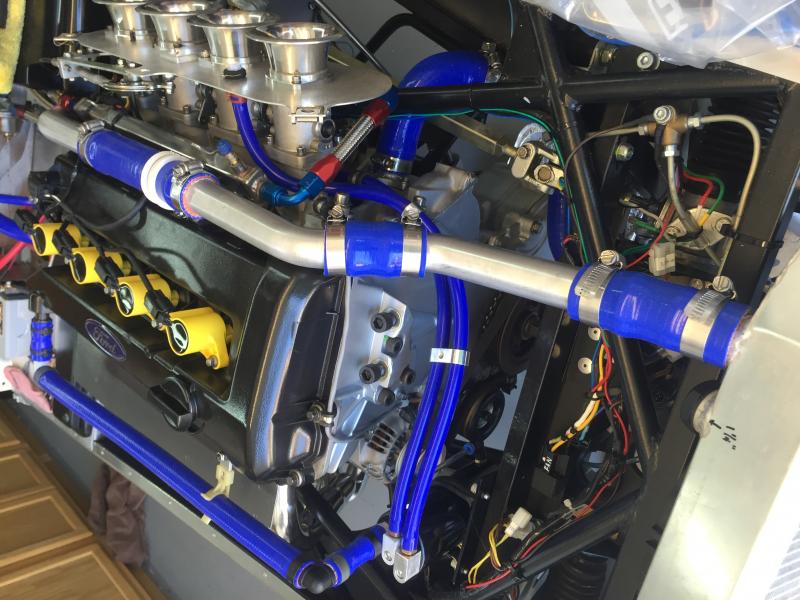-
Posts
476 -
Joined
Content Type
Profiles
Forums
Store
Articles
Gallery
Events
Library
Everything posted by papak
-

Birkin XS - side by side comparison to a Caterham CSR
papak replied to Croc's topic in General Sevens Discussion
My XS ended up at 1337# with driver, basic fluids, mounted spare and 6 gallons of gas. With the 2.3l Duratec and the factory skid pan, I have exactly 2" of ground clearance. I just finished installing a cold air box over the trumpets. I had an old "sausage" filter with worn-out foam. I removed the foam and glassed the SS wire frame, forming a 3" tube on the front end. A flexible duct with a foam "sock" type filter runs up next to the radiator. Less induction noise but a bit more power. Now I notice the exhaust note more. -
You might try John Esposito at Quantum Mechanics in Oxford, CT (*(203) 463-8299). He has been at it a good while now and probably knows who is around and worthwhile. No email.
-

Just bought a Birkin. Need transmission advice.
papak replied to PalaceOfFun's topic in General Sevens Discussion
I would second the recommendation for John at Quantum. Great guy, a straight shooter. -
Not sure if my pm got through. kpkehoe@ca.rr.com
-
I recall that when I originally went through the motor, I fully disassembled the tensioner to make sure everything was perfectly clean. I also installed new plastic guides. Simple but effective design.
-
When i rebuilt my motor, (out of a 2008 Ranger), I acquired a Focus front cover for just that reason. If I can figure out the idler retraction, I'll feel better about moving forward. Kevin
-
That’s a very helpful guide, Andy. A real confidence builder! Kevin
-
This is in the “consideration” stage right now before I seek a spousal spending authorization. I’ll take a close look at the link. The Stage one cams currently in the car only have 1500 miles or so on them. I would venture that another set of new cams would not be likely to need new buckets but I would certainly check them. On a side note, I have pulled the front cover with the motor in the car. It’s a pain in the ass to do it by yourself as I did. I actually acquired the tool to hold the crank pully. I would have assistance this time around. I’ll keep the thread updated if I move ahead with this. Thanks for the feedback.
-
Can the cams be changed in a Duratec with the motor in the car? It seems to me that the only real question is the chain tensioner.
-
You will have to get them from Tom. They start out as the unventilated front rotors from a ROW ‘98 Golf 1600. The backside is then machined down to a nominal 10.2mm (as I recall, the minimum rotor thickness stamped on the rim) from 12.5mm in order to fit within the caliper given the hub dimensions. The good news is that given the weight of the car and the fact that you will invariably have more front brake bias, they will probably last the life of the car.
-
I'm looking for a serviceable top cover for a Ford T-9. I keep getting a fine mist on mine through the vent hole in the cover. I want to try welding a bung in it's place to add a vent line. I just want to minimize my downtime as well as not having to order one from England. NOTE: I have a plug welded into the right front corner for dipstick/fill access. I swapped in a ⅜" hard line with a breather on it. Due to the mystique of fluid dynamics when underway, there apparently is a steady stream of lube aimed at that corner. I lost about ⅓ liter in an hour's driving! I spent yesterday cleaning up the mess and re-installing the plug.
-
This is then basics of the testing procedure used by the BAR (CCR 1036): - Indoors or outdoors, flat surface, no sound reflecting surface within 10' of any part of the vehicle. - The microphone shall be at the same height as the center of the exhaust outlet but no lower that 8". - the microphone shall be placed parallel to the ground, 20" from the nearest edge of the exhaust outlet and 45 degrees from the axis of the outlet. - engine at normal operating temperature with the transmission in neutral. The measurement will be taken at ¾ of the maximum RPM or at 3000rpm for pre-1972 cars where there is no maximum rpm data available. - Not to exceed 95db!
-
I was speaking to a couple of fellows at the Gardena C&C yesterday and the topic of noise limits came up. Apparently, California introduced a new policy as of January 1st, 2019. The new limit is 95 db as "observed" by a law enforcement officer. Instead of the old "fixit" $25 ticket of yore, the law now requires the issuing of a ticket between the minimum ($197) up to over $1000! The officer will have no testing equipment upon which to base this infraction. There is no provision for pre-certification either. Once you have paid your fine, you can make an appointment with a BAR (Bureau of Automotive Repair) station for testing (this is where you took your car for it's emissions waiver as the final step in the SB100 process). Only they can issue you a certification of noise level. There is a charge (undetermined) for this test. Take the certificate (presuming you passed) and your receipt back to the court clerk for reimbursement. You can dig into the BAR website for the testing criteria. There are various db apps for Iphone and Android devices. Most manufacturers cars rarely exceed 75 db. There are separate rules for motorcycles. I know of a couple of fellows currently changing mufflers on cars like ours. I'm testing my Birkin ( 2.3l Duratec) tomorrow and will post the results. My understanding is that this is pretty discretionary for the cops. It is most likely intended to give them a another tool for dealing with street racers and ___holes. At this potential cost point though, it pays to be aware and prepared.
-
One of the issues I ran into when constructing my Birkin was the electrical system. I realize that it was designed in South Africa to comply with the requirements of a variety of countries while meeting cost considerations. In particular, I didn’t like the plastic rocker switches. Neither was I happy with some of the gauge locations. After living with the car for over a year after completion, I decided to do something about it. I ended up cutting a new instrument panel from 14g aluminum sheet using knockout punches (3 1/8” and 2 1/16”) as well as step drill bits. This allowed me to use toggle switches to replace the rockers. One of the problems that arose was finding toggles that would function the same way due to how the car was wired. I have now investigated nearly every toggle switch on the internet and none, to my knowledge, fit the bill for replacing the rocker style hazard switch. The real issues centered around how the indicator and hazard lights are wired. I ended up reconfiguring the wiring to use a 5 pin relay to switch the power supply between the indicators flasher and the hazard flasher. Since I have committed to running Brooklands windscreens, I could utilize the existing windshield demister relay. I am attaching a schematic as well as the following description of the process. These instructions are unique to the Birkin but describe a strategy that could be applicable to any kit car. Both the indicator lights and the hazard lights each use a 10a fuse. This modification eliminates both and uses the windshield demister slot to hold the 10a fuse for the new circuits instead. Proceed as follows: Remove the battery and scuttle. Label the cluster of connectors for each existing switch clearly (take pictures as well). Remove the relays and the relay cluster. Note that there is very little slack in the wiring harness. The relay bases separate by sliding apart front to rear. 4. You will need an extraction tool to release the connectors from slot 87 and 87A from the demister relay base. Slide an inch or so of heatshrink over the connectors and reduce it to protect them. 5. Perform the same task on the 49 slot of the bases for the indicator and hazard flashers. 6. Connect the wires from the old demister switch to the two poles of the new toggle switch. This switch now controls the old demister relay (pin 85). 7. You now need to fabricate two lengths of 16 or 18g wire of a sufficient length to run from this relay to the outboard flasher bases. You will need ¼” “Ford" female spade connectors (I found mine at Pep Boys). These connectors have a small retaining tab on the back to hold them in place in the base. 8. Connect slot 87A to indicator flasher slot 49. Connect slot 87 to hazard flasher slot 49. 9. Verify that the existing G/w wire from indicator slot 49A runs to the center pin on the directional switch. 10.The hazard output (49A) connects to all four indicator lights and treats them as one. We need to maintain the separation of each side in order for the directional to work so we need to install a diode in both the left and right circuits. Think of it as a one-way check valve for current. You will need two 6a50v diodes (Maybe you could use smaller. I’m no electrical engineer.). I picked up a small “project box”, about 1 ½” x 2” to house and protect the connections. The ends of the diodes with the stripes are mounted toward the light bulbs. The other ends are soldered to the grey wire (12v regulated feed) from hazard flasher pin 49A. This connection is located near the original harness location about mid dash. The other ends are soldered to the green and yellow wires as appropriate to segregate the signal. Drill holes in the ends of the box as needed. I lined the box with a thin layer of foam and secured it to the existing harness bundle with a ziptie. Notes: Continually verify continuity as you trace wires. I carefully soldered all connectors and covered them with heatshrink tubing. If you change over to LED tail light bulbs, use CANBUS bulbs. They will correct for the reduced load of the LEDS to reduce hyper-flashing. If the turn signals flash together, you may still need load-reducing resistors in the circuits. http://www.usa7s.net/vb/attachment.php?attachmentid=14952&stc=1
-
The worst part of rebuilding one of these is that the manufacturer never intended for it to be rebuilt. No key ways, etc. Drill out the plugs from the oil journals and tap them for brass plugs. It’s the only way to assure that they are clean.
-
All set. Thanks to all.
-
Just think about how much knowledge you are accruing... sometimes it is the process, not the result, that is most enduring.
-
http://www.usa7s.net/vb/attachment.php?attachmentid=14837&stc=1http://www.usa7s.net/vb/attachment.php?attachmentid=14838&stc=1 I think I have it filed away somewhere. I'll post it over the weekend. If you are using the 1.25" aluminum tubing, I can loan you the flaring tool if you would like. It puts a nice ridge in the tube.
-
I found a local silicone hose supplier here in LA and used that along with some aluminum bends I found online. I did have to buy a flaring tool for the aluminum tube but the combination gives you a lot of flexibility in fitment. I think I got the bends from Summit or Speedway. Pegasus has the silicone hose but I got it cheaper locally.
-
You might try Tom Carlin (tbox56). Tom is the Birkin distributor. He might have a set for a Birkin that could fit.
-
If you want to replace the headlight switch with a toggle, use the Lucas 31788 (also shown as an SW42). This works as off/A on/AB on. This allows you to run the parking lights and headlights on the same with while retaining the high beam relay button. I have been speaking with Tom Carlin and we figure that I can use a simple on-off switch to control a five pin relay that will, in turn, control the power to either the hazard relay or the directional relay. The directionals will be the default and the hazards will be the switched circuit. I have spent a lot of time researching this and the only toggle switch I have found that will replace the headlight switch easily is the Lucas 31788. Everything else is usually a rocker or a pull switch. Ron Francis sells a toggle switch for a more directly wired hazard light system. It is a single throw/four pole switch. I will be using this as the on-off switch for ignition and other switched functions. If you are using a Typhoon ECU, you could wire the switched 12v supply to this switch but you would still need the un-switched 12v supply to run directly off the battery as the ECU needs power for about 5 seconds after shutdown to save the engine parameters to memory. The memory itself is non-volatile. While the fuel pump relay is powered via a relay from the ECU, it runs off the switched 12v supply. Consequently, the pumps lose power when the ECU is turned off.
-
This is the driest engine rebuild I think I have ever done. Nary a drop from anywhere. Nothing from the bottom of the bellhousing but an occasional drop from the output shaft seal when I park it facing uphill after a blat. I do have a fill plug on the top cover. I plan on replacing it with an Earls adapter and a -4 breather hose before I put it back on the road.
-
I may be wrong on the grade of lube. I'll have to check my notebook. There is only 1600 mi on the drivetrain. It's interesting because there is NO evidence of seepage anywhere else.
-
I recently noticed a pretty uniform film of oil on the top cover of my T-9. I know that there is a small breather hole in the cover (original from the manufacturer). Have I overfilled the gearbox? I believe that I have a liter or so of Lubrimoly 75-90 GL-5 in it. There’s is no leakage from anywhere else on the motor or the transmission. I guess that when I next pull the drivetrain, I will install a hose and route it to a catch can. Ant other thoughts on it?
-
I stand corrected. It’s Crower.




